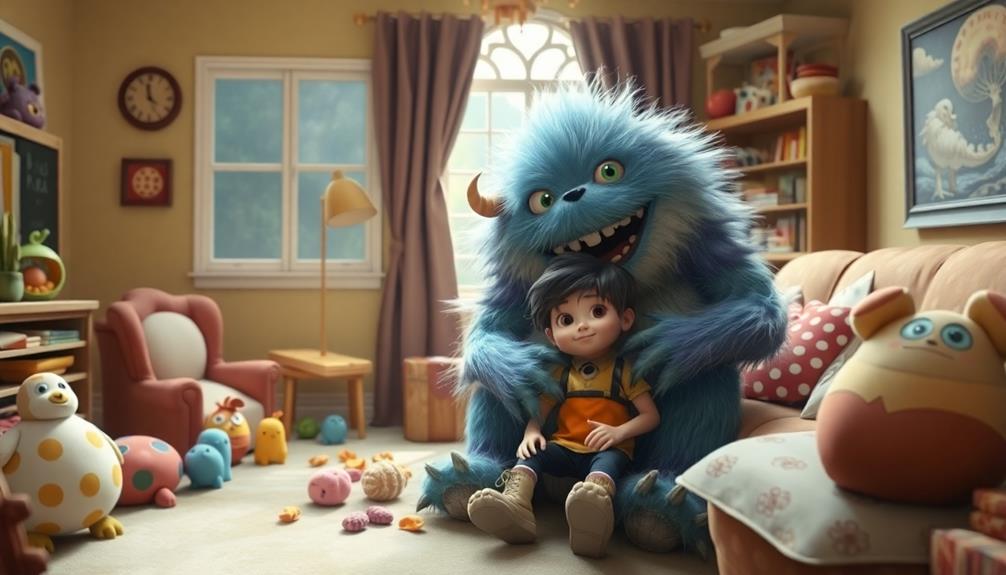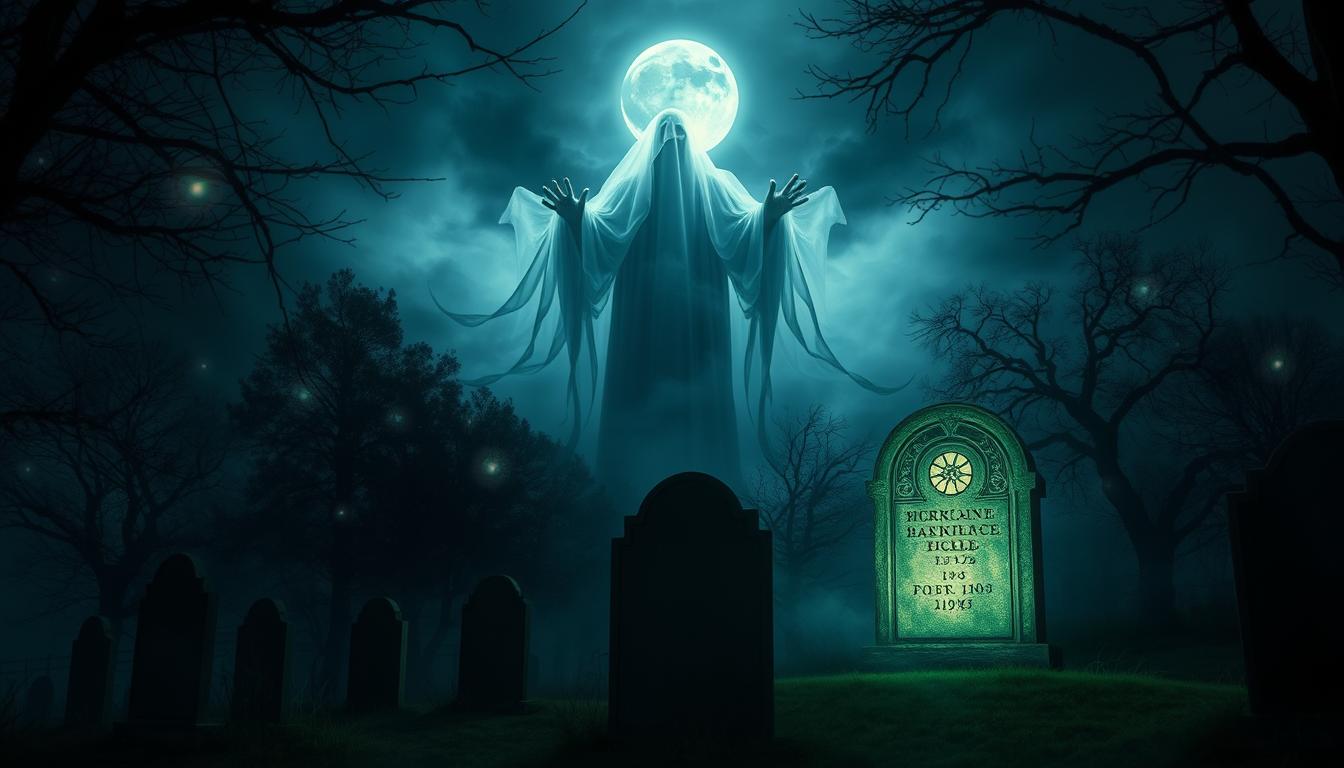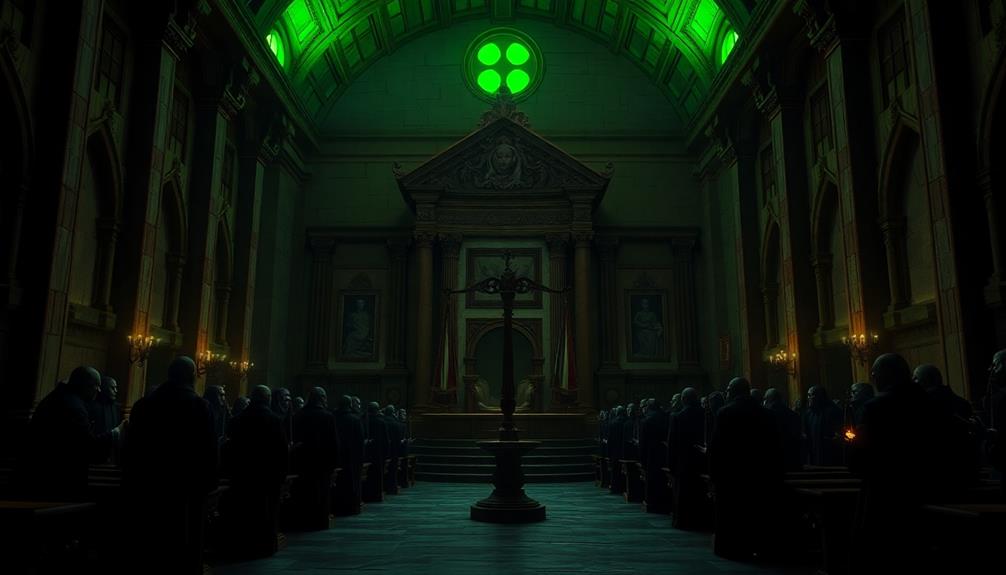If monsters revealed themselves to humanity, you'd find your world turned upside down. Suddenly, the lines between human and monster blur, forcing you to confront uncomfortable truths about identity and morality. Fear and confusion would reign as society grapples with the unknown. You'd witness a struggle for acceptance amidst rising tensions and deep-rooted anxieties. Ethical dilemmas would emerge, challenging your beliefs about victimhood and predation. Power dynamics might shift, leading to corruption and mistrust among leaders. As you navigate this new reality, you'd begin to see that understanding monsters isn't just about fear; it's also about empathy and coexistence. There's much more to contemplate.
Key Takeaways
- The revelation of monsters could destabilize societal norms, triggering fear and mistrust within communities, leading to potential violence and scapegoating.
- Monsters may struggle with their new identities, causing internal conflict between survival instincts and their past ethical frameworks.
- Societal fear could result in a lack of empathy towards monsters, complicating moral judgments and increasing isolation for both groups.
- Cultural narratives would shape public perception, either amplifying fears or fostering understanding, influencing the overall response to the revelation.
- Communication strategies would be essential to mitigate panic, promote rational responses, and encourage integration between humans and monsters.
The Nature of Transformation

Transformation is a powerful experience that can shatter your sense of self. When you undergo such a change, you might grapple with a new identity that feels foreign and overwhelming. This upheaval often brings forth a clash between your newly acquired instincts and the ethical framework you've built over a lifetime, complicating your decision-making.
As you navigate this transformation, your memories of who you were can haunt you, intensifying the struggle between your past and present.
Societal perception plays a significant role in how you respond to your monstrous form. If you face ostracism or persecution, you may find yourself embracing your new identity rather than resisting it. This acceptance can provide a sense of belonging, but it often comes at a cost—heightened feelings of isolation.
The emotional connections you once held dear may dissolve, leaving you feeling alone in a world that no longer understands you.
In this complex interplay of identity and instinct, the essence of who you become both a burden and a source of strength, shaping your journey through transformation in ways you never anticipated.
Psychological Impact on Humanity

The sudden revelation of monsters can shatter the mental equilibrium of society, thrusting individuals into a chaotic maelstrom of fear and uncertainty. You might experience psychological trauma as your self-identity is challenged, leaving you feeling threatened and dehumanized.
In this turmoil, empathy levels may plummet, as the fear of the unknown clouds your ability to connect with others, including those who sympathize with the monsters.
As you grapple with these emotions, internal conflicts arise; the struggle between your ethical beliefs and primal instincts can create moral ambiguity in your reactions. You may find yourself torn between curiosity and hostility towards these beings, reflecting a broader societal perception that shifts dramatically.
Responses will range from fascination to aggression, potentially exacerbating mental health issues within communities.
Isolation during the initial contact period could further intensify your feelings of anxiety and paranoia. The disconnection from your usual support systems leaves you alone to process the implications of coexisting with creatures once thought to be mere figments of imagination.
This psychological upheaval could redefine how you interact with the world around you, reshaping your understanding of humanity itself.
Moral Dilemmas and Justifications
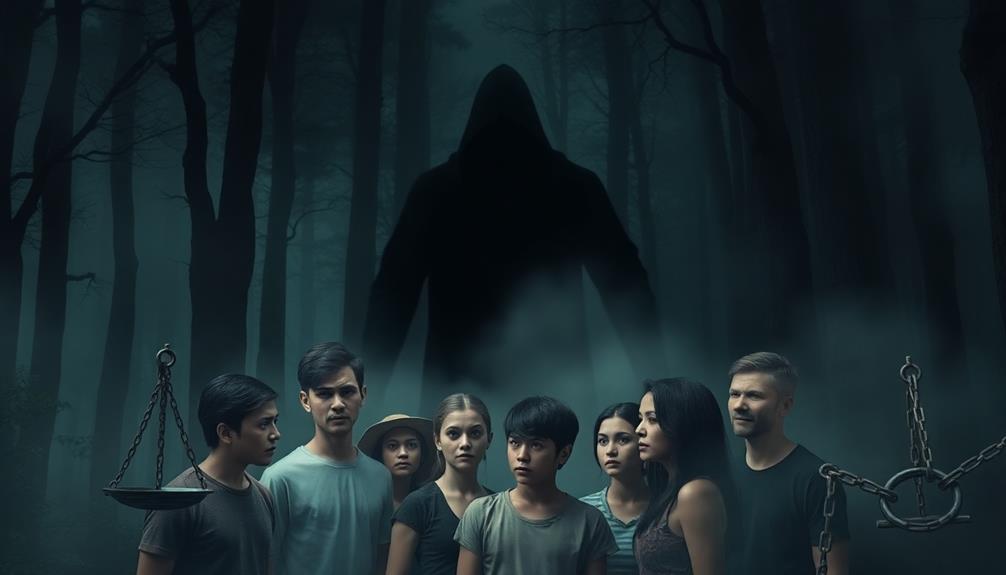
As humanity grapples with the psychological fallout from the emergence of monsters, moral dilemmas surface, forcing you to confront complex ethical questions. The moral ambiguity surrounding these beings challenges your understanding of right and wrong.
Monsters may justify their existence and actions based on survival instincts, framing their predatory behaviors as necessary responses to societal rejection. When you consider their perspective, it becomes clear that their monstrous identities could stem from a desperate need to survive in a world that ostracizes them.
This transformation can evoke internal conflict for both humans and monsters. As former humans embrace their new identities, they might struggle to reconcile their past ethics with the predatory instincts that now define them. You're left wondering whether their violent actions are justifiable in the face of rejection and fear.
These ethical quandaries force you to examine your own beliefs about morality. Should you condemn their actions, or can you find empathy for those who've been pushed to extremes?
The line between victim and monster blurs, complicating your moral judgments and challenging the very foundations of humanity's ethical frameworks.
Societal Reactions to Monsters

When monsters first reveal themselves, your immediate reaction might be fear and mistrust, echoing humanity's historical response to the unknown.
Yet, as you consider the possibility of acceptance and integration, it raises important questions about coexistence and what it truly means to be a monster.
How society chooses to respond could shape the future interactions between humans and these newfound beings.
Fear and Mistrust
Fear grips societies confronted with the reality of monsters, igniting a wave of mistrust that colors community interactions. You can't ignore the historical patterns where encounters with perceived threats lead to scapegoating and violence.
This fear of the unfamiliar often drives people into defensive coalitions, deepening divisions and misunderstandings. Cultural narratives have long depicted monsters as dangerous foes, amplifying societal anxieties and potentially triggering widespread panic.
Consider the implications of this fear:
- Increased hostility towards those perceived as different.
- Heightened surveillance and policing of neighborhoods.
- The creation of myths that dehumanize the "other."
- A rise in violence as communities react out of fear.
As these fears surface, questions about control and stability will dominate discussions. The existence of monsters challenges the established order, forcing you to confront existential questions about humanity's place in the world.
This fear and mistrust can spiral quickly, leading to a society where empathy is overshadowed by suspicion, making it harder for communities to unite in the face of the unknown.
Acceptance and Integration
Communities can shift from fear to acceptance when they recognize monsters as individuals with their own stories and struggles. By fostering empathy, you begin to see them not as threats, but as beings with shared histories. This understanding is essential for successful integration into society.
As you engage in open communication, both humans and monsters can navigate their shared existence and redefine previously held taboos. Through collaboration, you might discover common challenges, such as external threats or resource scarcity, that unite both groups. This potential for unity can foster a sense of belonging, making acceptance more attainable.
Education and awareness campaigns play a significant role in shaping public opinion, addressing fears and misconceptions. Community dialogues and shared experiences can help bridge the gap between you and monsters, allowing trust to flourish.
Ultimately, the success of acceptance and integration initiatives hinges on the willingness of both parties to engage. By prioritizing empathy and open communication, you pave the way for coexistence, transforming initial fear into a collaborative future.
Embrace this opportunity for growth, and you'll find that acceptance can lead to a richer, more diverse society.
Power Dynamics and Corruption
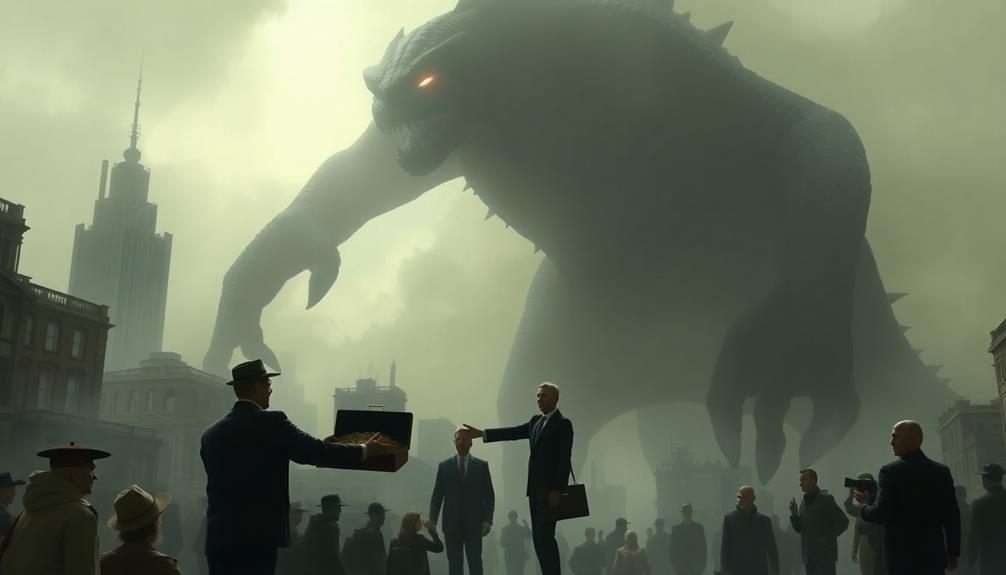
When power structures shift, you might notice how easily leaders can become corrupted, prioritizing their own interests over ethical considerations.
Instances of internet scandal and infidelity exposure highlight how public figures often fall from grace, revealing their monstrous behaviors.
This moral decay often stems from a transformation that alters their view of right and wrong, making them more susceptible to monstrous behaviors.
As you explore these dynamics, consider how the allure of power can distort even the most principled individuals.
Corruption of Power Structures
The corruption of power structures often emerges in the shadows, where the influence of monstrous entities can disrupt traditional hierarchies. As these beings reveal themselves, you'll see how power dynamics shift, causing individuals to abandon their moral compass. This unsettling transformation complicates not only ethical perspectives but also the relationships between humans and monsters.
AI technologies, much like these monstrous identities, can greatly enhance AI's role in cybersecurity and challenge established norms, leading to a reevaluation of ethical boundaries in leadership.
Consider the following aspects:
- Power can corrupt even those with strong ethical foundations.
- Monstrous identities may provoke a re-evaluation of societal perceptions.
- The absence of external threats allows for internal struggles that intensify corruption.
- Embracing or resisting monstrous identities influences choices and behaviors greatly.
In this new landscape, the realization of how easily one can succumb to corruption becomes a shared journey for both transformed monsters and humans in leadership roles.
As the lines blur, you'll notice how societal perceptions shape the behaviors of these entities. The potential for corruption weaves itself into the fabric of human communities, reminding you that even the most noble intentions can falter under the weight of power, especially when monstrous identities become intertwined with traditional power structures.
Moral Decay in Leadership
Corruption thrives in environments where power dynamics skew moral judgment, leading leaders to prioritize their self-interest over ethical obligations. You see, when individuals gain authority, their moral compass often falters. They rationalize decisions that align with personal gain, blurring the lines between right and wrong. Historical examples abound, showing that even those with a strong sense of justice can succumb to moral decay when faced with power.
This trend is particularly reflected in various sectors, including business, where increased interest in alternative investments can sometimes overshadow ethical practices. The ease of abandoning ethical considerations creates a culture of corruption, normalizing unethical behavior among leaders.
As you observe these dynamics, it becomes clear that this decay doesn't just remain isolated; it ripples through society, eroding public trust and welfare. When leadership is rooted in corruption, the consequences affect everyone, not just those in power.
Moreover, studies suggest that moral accountability decreases as power increases, leading to systemic issues within governance. In this light, you can understand why it's essential to scrutinize leadership structures.
Narrative Techniques in Storytelling
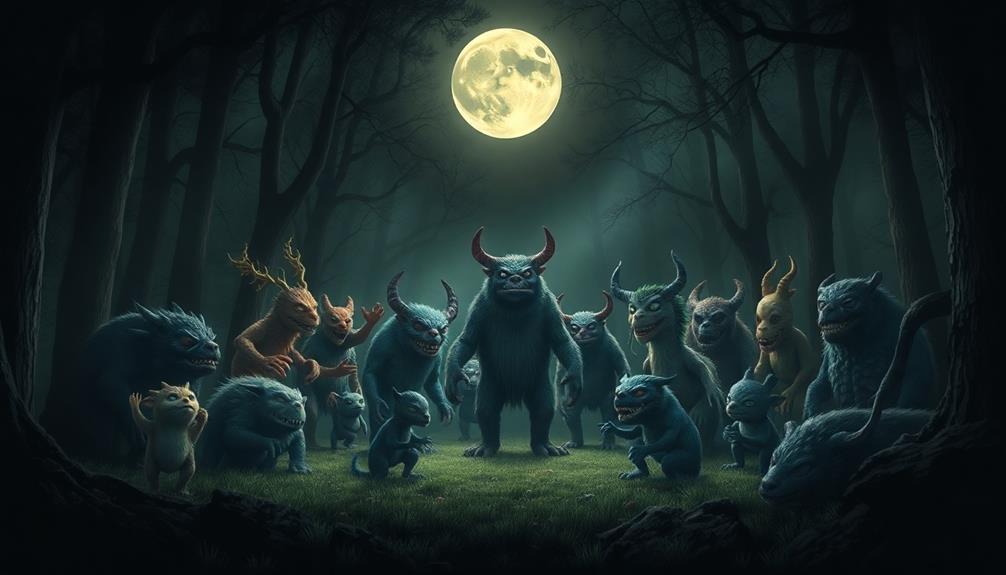
In storytelling, various narrative techniques can profoundly shape how audiences perceive characters, especially when it comes to monsters revealing their true selves to humanity. By employing these techniques, you can explore the emotional transformation of characters and investigate their complexities.
- Use unreliable narrators to create suspense, making readers question the monsters' true intentions.
- Incorporate flashbacks and character backstories to enrich the narrative, shedding light on the monsters' motivations and past experiences.
- Utilize symbolism to juxtapose monstrous appearances against human vulnerabilities, enhancing themes of fear and acceptance.
- Apply multiple perspectives to offer a nuanced view of the monsters' experiences, fostering empathy and challenging traditional tropes.
These narrative techniques not only heighten emotional engagement but also invite readers to reflect on the deeper meanings within the story.
Cultural Reflections and Perceptions

How do our cultural narratives shape the way we perceive monsters? They reflect societal fears and anxieties, crafting a lens through which you view the "other." Historical events, like the witch hunts of the 16th and 17th centuries, serve as stark reminders of how cultural perceptions can lead to persecution based on fear. In contrast, narratives featuring monsters can cultivate empathy, encouraging you to embrace coexistence rather than hostility.
Here's a look at how different cultural narratives influence perceptions of monsters:
| Cultural Narrative | Impact on Perception |
|---|---|
| Classic horror films | Heighten societal fears and anxiety |
| Folklore and mythology | Foster understanding and moral ambiguity |
| Modern fantasy and sci-fi | Encourage empathy and potential coexistence |
| Social media narratives | Shape contemporary views, inciting fear or acceptance |
| Documentaries on real monsters | Challenge perceptions, prompting reflection |
Ultimately, how you respond to the revelation of monsters hinges on these narratives. By exploring moral ambiguity and empathy, you might find that coexistence is not just possible, but necessary.
Evolutionary Themes in Literature

Through the lens of literature, evolutionary themes often highlight the complex relationship between humanity and monstrosity. You'll find that many narratives depict monsters as the next stage of human evolution, revealing how transformation can lead to new identities and moral dilemmas.
These stories often emphasize the struggle between past humanity and newfound instincts, reflecting internal conflicts during evolution.
Consider these key points:
- Monsters often retain memories of their previous lives, symbolizing the tension between old and new identities.
- Many creatures embody both human and monstrous traits, showcasing a spectrum of morality and the potential for empathy.
- Societal reactions to monsters reveal deep-seated fears and misunderstandings, influencing acceptance or ostracism.
- The shift from human to monster serves as commentary on the natural process of evolution and what it means to be human.
As you explore these themes, you'll see that literature encourages you to question the nature of identity and morality.
It challenges you to confront your perceptions of monstrosity, inviting deeper reflection on transformation and the human condition itself.
The Role of Fear in Society

Fear plays an essential role in shaping societal dynamics, often driving wedges between individuals and communities. It can lead to the ostracism of marginalized groups, as the fear of the unknown prompts strong reactions. When communities perceive threats, the fight-or-flight response kicks in, influencing collective behavior and decision-making.
| Aspect | Impact of Fear | Examples |
|---|---|---|
| Societal Divisions | Fear can create barriers between groups | Historical persecutions |
| Marginalized Groups | Often targeted due to perceived differences | Monsters in media |
| Acceptance | Fear can hinder integration efforts | Resistance to diversity |
| Resilience | Unites communities against challenges | Social movements for rights |
Throughout history, leaders have exploited fear to control populations, labeling certain groups as "monsters." However, fear can also foster resilience, prompting individuals to confront challenges together. Social movements advocating for the rights of marginalized groups showcase how communities can harness fear into a unifying force, ultimately promoting acceptance and understanding. As we consider the implications of monsters revealing themselves, it's clear that fear shapes our responses and interactions profoundly.
Preparing for the Unknown

As society grapples with the implications of monsters revealing themselves, the significance of preparing for the unknown becomes strikingly clear.
History shows a general lack of preparedness for unexpected events, like the COVID-19 pandemic. To avoid chaos, we need strategic planning that addresses potential societal impacts.
Consider these key areas for effective preparation:
- Establish communication protocols: Having guidelines ready can help mitigate panic and guarantee rational responses.
- Engage in interdisciplinary research: Understanding psychology, sociology, and ethics will help us anticipate how people might react and how media portrayals could influence public sentiment.
- Form international agreements: A unified response to monster revelations is essential. This prevents unilateral actions that could escalate tensions globally.
- Develop transparent communication strategies: In the age of misinformation, clarity in messaging will help manage public perceptions and maintain order during any monster revelation.
Conclusion
As the sun rises on this new reality, humanity stands at a crossroads, much like a ship steering through uncharted waters. Imagine the moment when sailors first spotted land; excitement mingled with fear. Monsters revealing themselves could spark a similar blend of wonder and dread. Just like those sailors, you must choose: embrace the unknown or retreat into darkness. Ultimately, it's your response to these "monsters" that will shape the future, defining what it means to be human.




